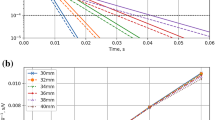Abstract
Two options for constructing an attached induction transducer for detecting steel objects in an iron ore stream on a conveyor belt are compared theoretically and experimentally. The options in which testing covers the entire conveyor belt width and where the stream width is divided into “tracks” are considered. A significant effect of magnetic interaction between rock particles magnetized by the eddy current transducer field is revealed. It has been shown that magnetizing ore stream locally can provide substantially better conditions for the selective detection of undesirable steel inclusions in the iron ore stream than across the entire stream width. However, the latter option is feasible only given certain proportions between the transducer dimensions and the conveyor belt width. The results of experimental verification are in satisfactory agreement with theoretical estimates.










Similar content being viewed by others
REFERENCES
Reutov, Yu.Ya., Obnaruzhiteli namagnichennykh predmetov (teoriya i praktika induktsionnogo obnaruzheniya) (Detectors of Magnetized Objects (Theory and Practice of Induction Detection)), Yekaterinburg: Dlya Vas, 2018.
Kostin, V.N. and Smorodinskii, Y.G., Multipurpose software-hardware systems for active electromagnetic testing as a trend, Russ. J. Nondestr. Test., 2017, vol. 53, no. 7, pp. 493–504.
Kostin V.N., Vasilenko, O.N., and Byzov A.V., DIUS-1.15M Mobile hardware–software structuroscopy system, Russ. J. Nondestr. Test., 2018, vol. 54, no. 9, pp. 654–661.
Druyts, P. and Acheroy, M., Modeling the response of electromagnetic induction sensors to inhomogeneous magnetic soils with arbitrary relief, IEEE Trans. Geosci. Remote Sens., 2009, vol. 47, no 8, pp. 2627–2638.
Huang Haoping and Won, I.J., Electromagnetic detection of buried metallic objects using quad-quad conductivity, Geophysics, 2004, vol. 69, no. 6, pp. 1387–1393.
Boiko, P.F., Titievskii, E.M., and Timiryazev, V.A., Technological features of operation, repair, restoration, and modernization of cone crushers of large unit capacity, Gorn. Zh., 2017, no. 4, pp. 71–75.
Shchupov, V.P., Monya, G.M., and Obodan, V.Ya., Summarizing the experience of protecting crushers with conveyor metal detectors, Metall. Gornorudn. Prom-st., 2006, no. 4, pp. 97–100.
Tarakanov, E.A., Research and development of devices for monitoring the presence of foreign metal objects in raw materials of mining and metallurgical production, Cand. Sci. (Eng.) Dissertation, Norilsk, 2008.
Smotritskaya, B.I., Research of a method for identifying metal objects dangerous for crushers in an ore stream at processing plants, Extended Abstract Cand. Sci. (Eng.) Dissertation, Sverdlovsk: Sverdlovsk Gorn. Inst. im. V.V. Vakhrusheva, 1970.
Fizicheskie svoistva gornykh porod i poleznykh iskopaemykh / Spravochnik geofizika (Physical Properties of Rocks and Minerals / Handbook of Geophysicist), Dortman, N.B., Ed., Moscow: Nedra, 1984.
Spravochnik po obogashcheniyu rud chernykh metallov (Handbook of Iron Ore Beneficiation), Shinkorenko, S.F., Ed.: Moscow: Nedra, 1980.
Bida, G.V. and Nichipuruk, A.P., Magnitnye svoistva termoobrabotannykh stalei (Magnetic Properties of Heat-Treated Steels), Yekaterinburg: Ural Branch, Russ. Acad. Sci., 2005.
Reutov, Yu.Ya., Characterization of an object detected by its magnetic field, Defektoskopiya, 1998, no. 2, pp. 10–17.
Grinkevich, G.I., Magnitorazvedka (Magnetic Exploration), Moscow: Nedra, 1987.
Pechenkov, A.N., Shcherbinin, V.E., Shleenkov, A.S., and Bulychev, O.A., Exact formulas for calculating 3D magnetic fields of some uniformly magnetized permanent magnets, Defektoskopiya, 2018, no. 11, pp. 49–54.
Reutov, Y.Y., A ferromagnetic disk in a constant axially symmetric inhomogeneous magnetic field, Russ. J. Nondestr. Test., 2015, vol. 51, no. 3, pp. 146–150.
Funding
The work was carried out on the budget topic “Diagnostics”, project no. AAAAA-A18118020690196-3.
Author information
Authors and Affiliations
Corresponding author
Additional information
Translated by V. Potapchouck
Rights and permissions
About this article
Cite this article
Reutov, Y.Y. Influence of Magnetization Options on Detection of Unwanted Inclusions in the Tonnage of Iron Ore. Russ J Nondestruct Test 55, 663–671 (2019). https://doi.org/10.1134/S1061830919090079
Received:
Revised:
Accepted:
Published:
Issue Date:
DOI: https://doi.org/10.1134/S1061830919090079



